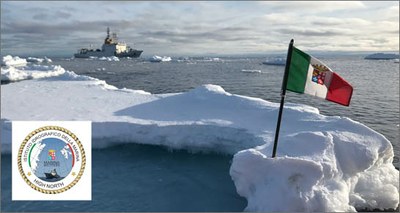Environment: ENEA part of "High North 21", the Arctic mission of the Navy
29/7/2021
 Microplastic pollution, climate change and biodiversity in the Arctic Ocean: these are the main targets of research by ENEA in the Arctic marine geophysics campaign of the Italian Navy "High North 21", which will end at the end of July with the return of the ship Alliance[1] in the port of La Spezia, after sailing for more than one month around the North Pole.
Microplastic pollution, climate change and biodiversity in the Arctic Ocean: these are the main targets of research by ENEA in the Arctic marine geophysics campaign of the Italian Navy "High North 21", which will end at the end of July with the return of the ship Alliance[1] in the port of La Spezia, after sailing for more than one month around the North Pole.
Scientifically coordinated by the Navy Hydrographic Institute, the mission involves a multidisciplinary team of ENEA researchers with the task of analyzing the samples collected in the laboratories of the Santa Teresa Center (La Spezia), to assess the health of the Arctic Ocean, in particular that of unexplored areas near sea ice and new environmental observation sites.
The study will focus on the recent geochronology of the sediments of the Arctic bottoms at different latitudes and with different morphologies, to understand the sedimentary dynamics taking place on still largely unexplored Arctic bottoms; on phytoplankton and chlorophyll "a" in surface and sub-surface Arctic waters, to study biodiversity and distribution of biomass, sensitive to climate change and essential for the balance of the ocean ecosystem; on radionuclides in the water column, as tracers to characterize the different masses of water that play a key role in the the Earth's climate (in collaboration with the International Atomic Energy Agency IAEA in Munich and the Centro Nacional de Aceleradores of Seville).
Another line of investigation will be conducted on contaminants and microplastics in water, sediments and ice, to understand the degree of contamination that has reached these extreme latitudes.
“ENEA has collaborated in the High North missions since 2017 and the data collected in previous campaigns show that even in these areas, which are far from direct sources of pollution, there are high concentrations of microplastics. From the first results, obtained in synergy with the CNR-ISMAR of Lerici, fibers appear to be the most frequent type of particles in surface waters, followed by foams and fragments.
Analyses are still underway for polymer determination of microplastics, using infrared spectroscopy which will allow us to distinguish the most frequent types of polymers ", explained Ivana Delbono, researcher at the Biodiversity and Ecosystem Services Laboratory in the ENEA Santa Teresa Center and coordinator of the Arctic mission for the Agency.
In addition to post-mission laboratory activities, ENEA has made available on board the Alliance ship a compact sensor developed and patented by researchers from the Diagnostics and Metrology Laboratory of the Frascati Research Center. Called CASPER (Compact Laser Spectrometer), it allows to analyse and characterize water in real time and to calibrate and validate satellite data. Among the detectable substances there are algal pigments (such as chlorophyll "a") and chromophoric dissolved organic substance (CDOM). In particular, this tool allows to identify, in different environmental conditions and without the need for complex laboratory preparations of the sample, the distribution of phytoplankton biomass, eutrophication phenomena or anthropogenic spills of pollutants.
CASPER has recently been implemented with LED technology and a wireless remote control system. The device, more compact than the previous one, is based on two excitation sources - a laser in the blue and a UV LED - optically connected to a measuring cell. The sample-induced fluorescence radiation in the cell is collected by an optical fiber coupled to a spectrometer. A digital system allows sensor management, data acquisition and geolocation of sampling stations, even remotely from a smartphone.
The High North 21 team is composed of 45 crew members and 20 researchers and scientists from the Hydrographic Institute of the Navy, the NATO Center for Maritime Research & Experimentation (CMRE) and the Joint Research Center (JRC) of the European Commission. The six young people present in the scientific team are proof of the particular attention the Navy pays to training, to concretely support the United Nations action for the Decade of Ocean Science for Sustainable Development 2021-2030, with the program dedicated to the Ocean Generation - Early Carrier Ocean Professional - for the vision of the decade “the science we need for the ocean we want”. A fundamental contribution to the environmental monitoring activity is the collaboration with the main Italian research centers (in addition to ENEA, there are CNR, OGS and lNGV) and the Norwegian Research Institute Norwegian Defense Research Establishment FFI.
For more information:
https://www.marina.difesa.it/cosa-facciamo/per-la-ricerca/Pagine/high_north.aspx
Italian Navy photos: https://marinamilitare.app.box.com/v/PRESS-HN21-ENEA/file/830875328477
[1] NATO multi-purpose research unit with crew and flag of the Italian Navy
